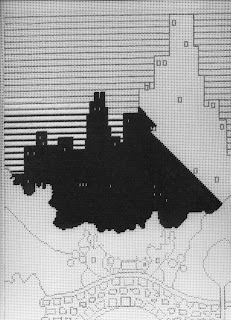
When I get an idea for a needlepoint design, my usual modus operandi is to sit down with a pencil and 10-squares-to-the-inch graph paper. I measure, I count, and then I count again--heck, I'm a stitch painter. Only when every square is accounted for do I actually transfer the design to canvas, each square faithfully recreated on one canvas intersection.
I quickly realized this tried-and-true method wouldn't work for my new project--my father's line drawing of Central Park. I'd need a piece of graph paper the size of Massachusetts--well, maybe Rhode Island? I happened to hold a piece of doodle canvas in front of the enlargement of the original art, and knew I had my solution--trace it! Being a black and white line drawing, the artwork showed beautifully through 18 ct. canvas.
The enlargement was 9-1/2 inches by 15 inches, so I cut a piece of blank canvas 14 inches by 20 inches. I then taped the enlargement to a piece of plywood larger than the canvas by several inches all around. I placed the canvas on top of the enlargement, lining up the outside edges so they corresponded to the vertical lines of the canvas, and taped down the canvas with masking tape. I figured--correctly--that it might take a couple of days to transfer the entire design, so I burnished the masking tape to the plywood by running the blunt end of a kitchen knife several times across the surface. I wasn't going to take the chance of the canvas shifting when I moved the plywood around.
I used the kitchen counter as my work table, since it's much higher than my work table and would keep me from having to lean over for long periods. Starting at the easiest section--the skyscrapers--I carefully traced the outline with a black Sharpie (yes, Virginia, it IS permanent). When I say "trace," I don't mean in the conventional way. More accurately, I "stitch-traced." When I got to a section which didn't exactly match up to a canvas intersection, I made the decision which intersection most closely followed the design and marked it. When I sit down to stitch a painted canvas, I want to enjoy myself, not have to make countless decisions about where one color ends and the next one begins. That's why I became a stitch painter in the first place.
The only parts of the design I didn't stitch-trace were the lines in the sky. I had already determined that they were three horizontal canvas lines apart, more or less, so I drew them in that way when I'd finished transferring the rest of the design.
My resulting canvas actually looks more like a line-drawn canvas than a painted canvas. But it is all black and white, and I made another executive decision: not to fill in the solid black areas and give my poor eyeballs a break. I already knew which thread I would be using for the skyscrapers and was completely confident that the thread would cover the white canvas completely.
As is probably true of a lot of stitchers, I was "hot to trot" to start stitching--and I did! I had my first thread already in my stash, and lost no time making a beginning on this canvas. Here's my progress to date!
Next up: how to change a two-dimensional drawing into 3-D needlepoint.














